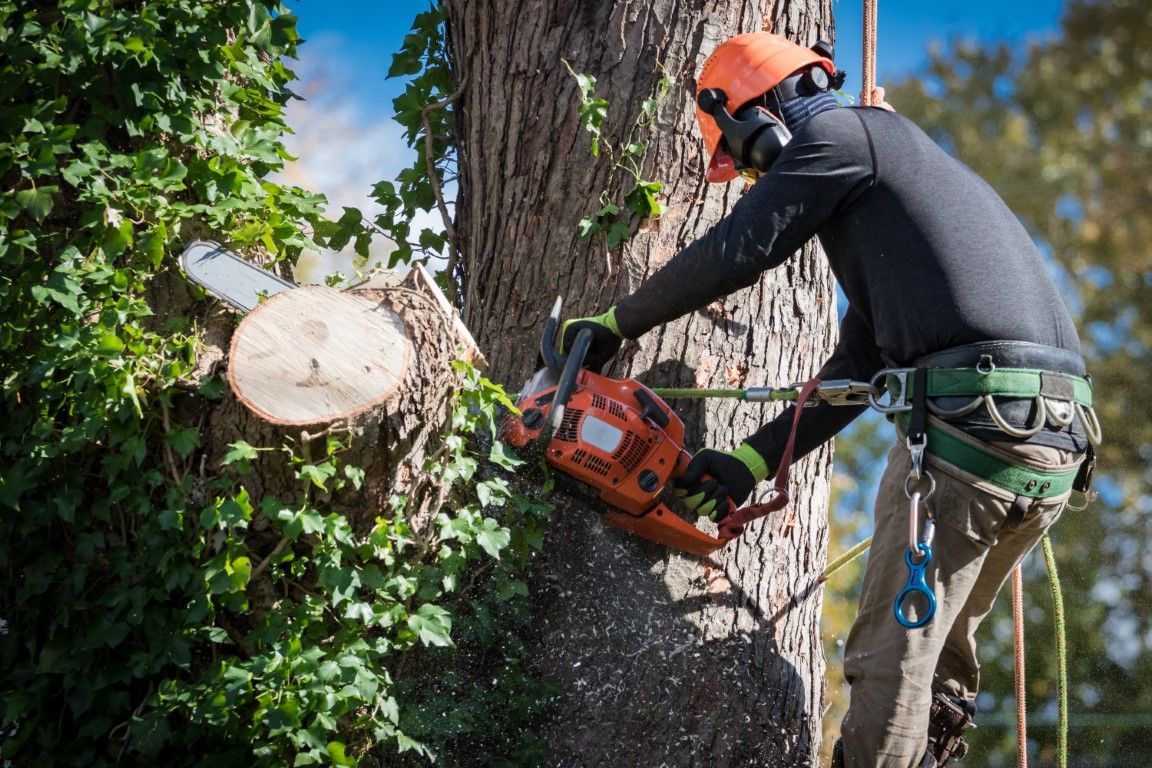
Riverton Tree Service
Happiness of Client And Quality Service,
Always Our Priority
Tree Cutting in Riverton UT
Tree cutting refers to the process of removing a tree, either partially or completely. This procedure involves trimming or felling a tree to control its size, remove damaged parts, or eliminate it entirely for safety or aesthetic reasons. The method used can vary based on the tree's location, size, and condition.
Importance of Proper Tree Cutting
Proper tree cutting is crucial to ensure the health of the surrounding environment and to maintain safety. Incorrect techniques can lead to tree damage, potential hazards, or harm to nearby structures. By following best practices, tree cutting can be done efficiently and safely, preserving the tree’s health and avoiding damage to the landscape.
Reasons for Tree Cutting
There are several reasons why tree cutting may be necessary. Often, it is required to remove dead or diseased trees that pose a risk to property or people. Trees might also be cut to prevent interference with power lines, reduce shading on solar panels, or make room for new construction. Additionally, tree cutting can be done for aesthetic reasons or to improve the health and growth of other trees by thinning out crowded areas.
Types of Tree Cutting
Tree cutting encompasses a range of techniques. Selective cutting involves removing specific branches or parts of the tree to shape it or remove hazards. Thinning is the process of selectively removing some trees from a stand to reduce competition and enhance the growth of the remaining trees. Complete removal, or felling, involves cutting down the entire tree and is often done when the tree is beyond saving or needs to be removed for construction.

FREE 100% INSTANT QUOTE!
FREE 100% INSTANT QUOTE!
Thank you for contacting Riverton Tree Services.
We will get back to you as soon as possible.
Please try again later.
Best Practices for Tree Cutting
Following best practices is essential for effective tree cutting. Before starting, it's important to assess the tree’s condition and plan the cutting process carefully. Use appropriate tools and equipment to ensure precision and safety. Always wear protective gear, such as helmets and gloves, and be aware of your surroundings to avoid accidents. It’s also beneficial to hire a professional arborist who can offer expertise and handle the job safely and efficiently.
Environmental and Ecological Considerations
Tree cutting has significant environmental and ecological impacts. Removing trees can affect local wildlife habitats and soil health. It’s important to consider these factors before proceeding with cutting. Using sustainable practices and ensuring that cutting is done in a way that minimizes disruption to the ecosystem can help mitigate negative effects. Planting new trees and maintaining a balanced landscape can also support ecological health.
Post-Cutting Care and Cleanup
After tree cutting, proper care and cleanup are vital. Removing tree stumps and debris helps maintain a tidy area and reduces potential hazards. In some cases, the wood can be repurposed or used for firewood. It’s also important to monitor the area for any remaining issues, such as pests or diseases, that might need addressing. Ensuring that the site is properly cleaned up helps in preserving the aesthetic and functional value of the landscape.
If you need professional
tree cutting services in Riverton, UT, contact us today. Our team of experts is ready to assist you with all your tree cutting needs, ensuring that the job is done safely and efficiently. Whether you require tree removal, trimming, or any other tree-related service, we’re here to help. Reach out to us to schedule a consultation and get started on maintaining the health and beauty of your landscape.
Understanding the Different Methods of Tree Cutting
Tree cutting is a crucial part of maintaining both residential and commercial landscapes. It can involve various techniques, each suited to different types of trees and purposes. Whether you're clearing land, maintaining a healthy landscape, or dealing with a hazardous tree, understanding the different methods of tree cutting can help you make informed decisions and ensure safety. Tree cutting, or tree removal, can be approached in several ways, depending on the size and location of the tree, as well as the surrounding environment. Each method has its advantages and specific applications:

Traditional Felling
This method involves cutting a tree down in one go. It's commonly used for trees that are free-standing in open areas. The process starts with a notch cut on the side facing the direction of the fall. Then, a back cut is made on the opposite side. The tree falls in the intended direction, and this technique is ideal for trees that are not near structures or other obstacles.
Sectional Removal
For trees that are in confined spaces or near structures, sectional removal is a safer method. This technique involves cutting the tree into smaller sections, starting from the top and working downward. Each section is carefully lowered to the ground using ropes and pulleys. This method minimizes the risk of damage to surrounding areas and is often used in urban environments.
Climbing and Pruning
Sometimes, only certain parts of a tree need to be removed or trimmed. Climbing and pruning involve an arborist climbing the tree and selectively cutting branches. This method is ideal for maintaining the health and shape of the tree without removing it entirely. It also allows for targeted removal of diseased or dead branches, which can improve the tree's overall health and appearance.
Tree Dismantling
When dealing with particularly large or hazardous trees, dismantling is a specialized approach. This method involves removing the tree in pieces, often using cranes or other heavy equipment. Each piece is carefully cut and lowered to the ground, reducing the risk of falling debris and ensuring a controlled removal process. Tree dismantling is commonly used in situations where traditional felling is not feasible due to the tree’s location or size.
Stump Grinding
After a tree has been removed, the remaining stump can be ground down to below ground level using a stump grinder. This process involves using a machine with a rotating blade to chip away at the stump and its roots. Stump grinding is essential for removing the remnants of a tree and preventing regrowth, which can be particularly useful in areas where new landscaping is planned.
Chemical Treatment
In some cases, chemical treatments may be used to aid in the tree removal process. This involves applying chemicals to the stump or roots to accelerate decomposition. While not a cutting method per se, it can be used in conjunction with other techniques to manage the remains of a tree. Chemical treatment is often a slower process and is used when immediate removal is not necessary.
Understanding these methods helps in choosing the most appropriate technique for your specific situation. Each method has its own set of considerations, including safety, efficiency, and impact on the surrounding environment.
If you have a tree that needs to be cut or managed, it's important to consult with professionals who have the expertise and equipment to handle the job safely and effectively. We offer a range of tree cutting services tailored to your needs. Our team of experienced arborists can assess your situation and recommend the best method for your tree cutting project. Contact us today to discuss your needs and schedule a consultation. Let us help you keep your landscape healthy and safe.
Tree Cutting for Storm Damage Prevention: What You Need to Know
Trees are more than just a beautiful addition to your landscape—they also play a crucial role in the environment by providing shade, enhancing air quality, and supporting wildlife. However, when it comes to storm damage, trees can become a significant liability. Branches and trees that are not properly maintained can cause substantial harm to property and people during severe weather events. When it comes to safeguarding your property from storm damage, proactive tree maintenance is key. Here are some essential points to consider:
Regular Inspections
Regularly inspecting your trees is the first step in preventing storm damage. Look for signs of disease, decay, or structural weaknesses. An arborist can assess the health of your trees and recommend necessary actions. Keeping an eye on the overall condition of your trees can help you catch potential issues before they escalate.
Pruning and Trimming
Proper pruning and trimming are vital in reducing the risk of storm damage. Removing dead or overgrown branches can prevent them from breaking off and causing damage during high winds. Trimming trees to maintain a balanced shape can also help them withstand strong gusts.
Tree Removal
In some cases, removing a tree might be necessary to prevent potential damage. Trees that are leaning excessively or have a compromised root system can pose a significant risk. A professional can help determine if a tree needs to be removed or if it can be salvaged with proper care.
Root System Health
A tree's root system is crucial for its stability. Ensuring that the roots are healthy and well-established can help the tree resist being uprooted during storms. Avoid activities that could damage the root system, such as construction or heavy landscaping near the tree.
Professional Services
While some tree maintenance tasks can be done by homeowners, it's often best to hire a professional arborist. They have the expertise and equipment needed to safely handle tree cutting, pruning, and removal. Professional services can also provide a thorough assessment and ensure that all work is done according to safety standards.
Post-Storm Assessment
After a storm, inspect your trees for any damage or hazards. Look for broken branches, splits in the trunk, or other signs of stress. Addressing these issues promptly can prevent further damage and ensure the safety of your property.
Tree cutting for storm damage prevention is an essential aspect of property maintenance. By staying proactive and seeking professional help when needed, you can protect your home and loved ones from the dangers posed by storm-damaged trees. If you need assistance with tree cutting, pruning, or removal, don’t hesitate to contact us today. Our team of experts is here to provide you with the services and advice you need to keep your property safe and beautiful.
Let's Work Together!
We take pride in our workmanship and guarantee that you'll be satisfied with the results. Our team of experts has years of experience in providing tree removal, pruning, cabling, stump grinding, and much more. We use state-of-the-art equipment to ensure that the job is done safely and efficiently
Quick Links
Company Info
Riverton Tree Services. All Rights Reserved.